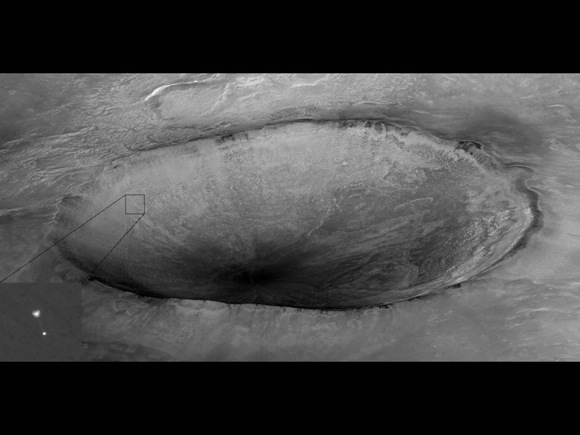The planet Mars is one of the most photographed objects in the Solar System. There are hundreds of thousands of images of Mars, seen from the ground, from orbit around the planet, and from here on Earth. With so many photos of Mars to choose from, it’s impossible to show them all, but we can show some of our favorites.
This is a picture of Mars captured by the Hubble Space Telescope on October 28, 2005, when Mars was just about to make its closest approach to Earth. If you look carefully, you can see a regional dust storm. When this amazing pic was taken, the dust storm was about the size of Texas.

This is a picture of Mars captured by NASA’s Mars Exploration Opportunity rover. It shows the Victoria Crater on the surface of Mars. Opportunity slowly made its way up to the edge of the crater, and then crawled down inside to examine the rock walls for past evidence of liquid water on the surface of Mars.

This looks like a plain old image of a crater on Mars, but it’s much more special than that. The inset box on the left-hand side is NASA’s Phoenix Mars Lander descending to the surface of Mars. The image was captured by NASA’s Mars Reconnaissance Orbiter which had been positioned to watch the spacecraft descend.

The largest canyon in the Solar System is the amazing Valles Marineris on Mars. Stretching more than 4,000 km long, and as deep as 7 km, it would cross the United States if put on Earth. This is a photograph of just one portion of the canyon, captured by ESA’s Mars Express spacecraft.

More than 1000 separate pictures of Mars captured by the Viking Orbiter were stitched together to create this composite image of Mars. This is one of the most beautiful, high-resolution images of Mars ever captured. Olympus Mons and the other large volcanoes are on the left-hand side of the photo. Valles Marineris is down at the bottom, and the northern polar ice cap is up at the top.
Want more photographs of Mars, just click here to search Universe Today and see hundreds of photographs.
Here’s NASA’s photo gallery of Mars. And additional pictures of Mars from Nine Planets.
Finally, if you’d like to learn more about planet Mars in general, we have done several podcast episodes about the Red Planet at Astronomy Cast. Episode 52: Mars, and Episode 91: The Search for Water on Mars.









